2015 FIAT 500L LIVING start stop button
[x] Cancel search: start stop buttonPage 10 of 224
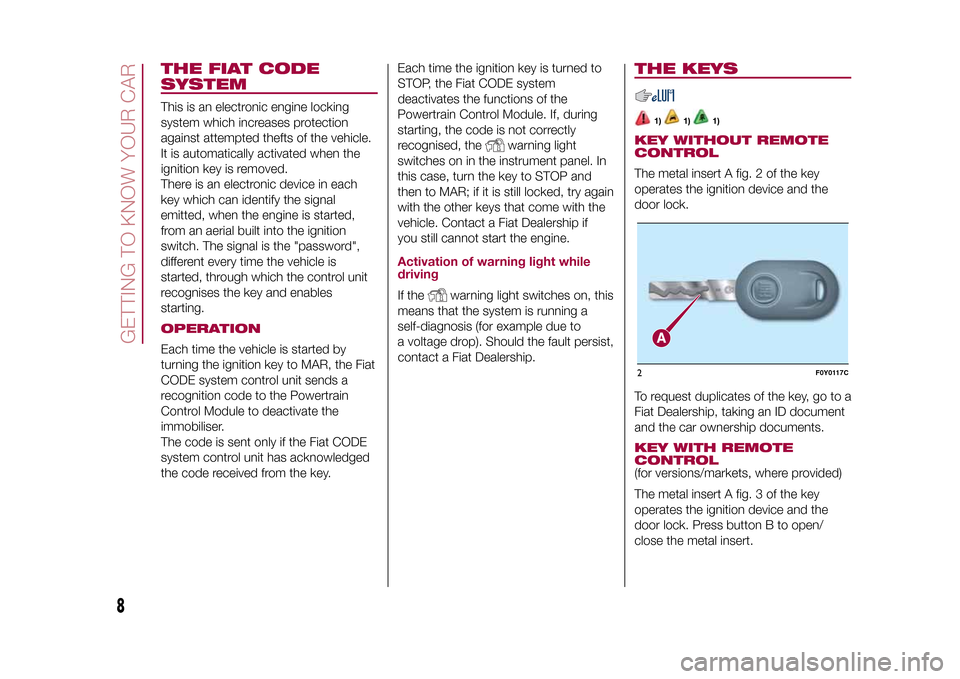
THE FIAT CODE
SYSTEMThis is an electronic engine locking
system which increases protection
against attempted thefts of the vehicle.
It is automatically activated when the
ignition key is removed.
There is an electronic device in each
key which can identify the signal
emitted, when the engine is started,
from an aerial built into the ignition
switch. The signal is the "password",
different every time the vehicle is
started, through which the control unit
recognises the key and enables
starting.OPERATIONEach time the vehicle is started by
turning the ignition key to MAR, the Fiat
CODE system control unit sends a
recognition code to the Powertrain
Control Module to deactivate the
immobiliser.
The code is sent only if the Fiat CODE
system control unit has acknowledged
the code received from the key.Each time the ignition key is turned to
STOP, the Fiat CODE system
deactivates the functions of the
Powertrain Control Module. If, during
starting, the code is not correctly
recognised, the
warning light
switches on in the instrument panel. In
this case, turn the key to STOP and
then to MAR; if it is still locked, try again
with the other keys that come with the
vehicle. Contact a Fiat Dealership if
you still cannot start the engine.
Activation of warning light while
drivingIf the
warning light switches on, this
means that the system is running a
self-diagnosis (for example due to
a voltage drop). Should the fault persist,
contact a Fiat Dealership.
THE KEYS
1)
1)
1)
KEY WITHOUT REMOTE
CONTROLThe metal insert A fig. 2 of the key
operates the ignition device and the
door lock.
To request duplicates of the key, go to a
Fiat Dealership, taking an ID document
and the car ownership documents.KEY WITH REMOTE
CONTROL(for versions/markets, where provided)
The metal insert A fig. 3 of the key
operates the ignition device and the
door lock. Press button B to open/
close the metal insert.2
F0Y0117C
8
GETTING TO KNOW YOUR CAR
9-1-2015 12:9 Pagina 8
Page 44 of 224

DISPLAYMULTIFUNCTION
DISPLAYThe following information is shown on
the display fig. 56:A
Date
B
Activation of Dualdrive electric power
steering (CITY indication) or of ECO
driving mode (ECO indication)
C
Gear Shift Indicator (for versions/
markets, where provided)
D
Headlight alignment position (only
with dipped beam headlights on)
EOdometer (display of distance
travelled in kilometres/miles)FTime (always displayed, even with key
removed and doors closed)G
Stop/Start function indication (for
versions/markets where provided)
H
Outside temperature (for versions/
markets, where provided)
I"Speed limiter" display (for versions/
markets, where provided)RECONFIGURABLE
MULTIFUNCTION
DISPLAYThe following information is shown on
the display fig. 57:A
Time
B
Date or trip distance display in
kilometres (or miles)
C
Gear Shift Indicator (for versions/
markets, where provided) or
Stop/Start function indication (for
versions/markets, where provided)
D
"Speed limiter" display (for versions/
markets, where provided)
EOdometer (display of distance
travelled in kilometres/miles)
FHeadlight alignment position (only
with dipped beam headlights on)G
Outside temperature (for versions/
markets, where provided)
H
Vehicle status indication (e.g. doors
open, possible ice on road, etc.)
GEAR SHIFT INDICATORThe GSI (Gear Shift Indicator) system
advises the driver to change gear
through a specific indication on the
instrument panel. Through the GSI, the
driver is informed that the gear change
will allow a reduction in fuel
consumption.
"SHIFT UP" icon(
SHIFT): the GSI
suggests to make an upshifting
"SHIFT DOWN" icon(
SHIFT): the
GSI suggests to make a downshifting.
The icon remains displayed until a
gear is shifted or the driving conditions
go back to a situation where
gearshifting is not required, to improve
consumption.
CONTROL BUTTONSThe
and
buttons are located
in the instrument panel fig. 58. The
buttons are
and
on some
versions.
To scroll up through the screen and the
related options or to increase the
displayed value.
56
F0Y1101C
57
F0Y1103C
42
KNOWING THE INSTRUMENT PANEL
9-1-2015 12:9 Pagina 42
Page 67 of 224
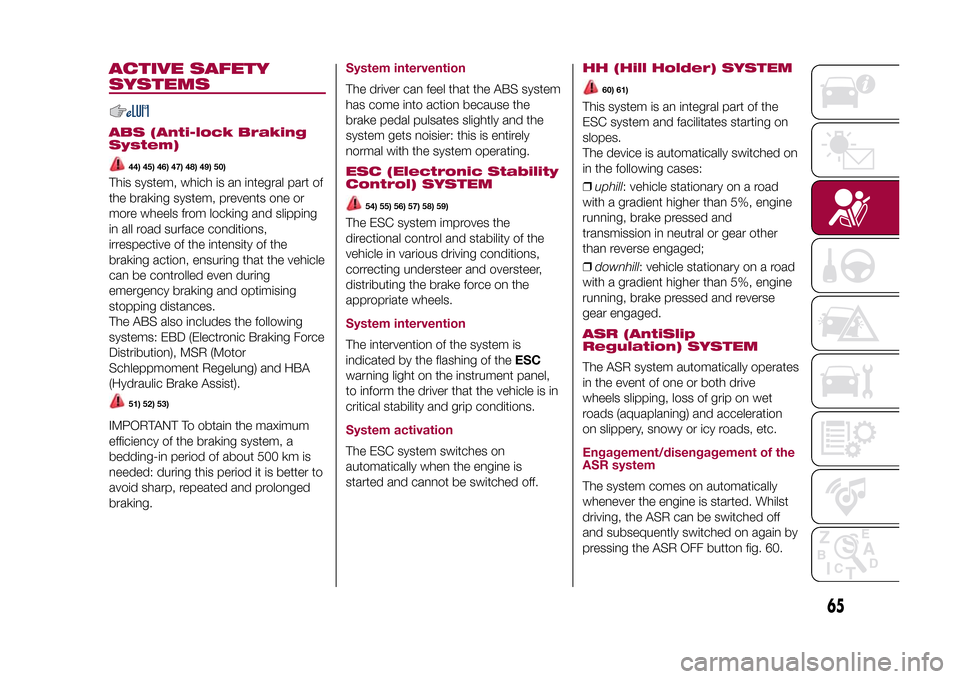
ACTIVE SAFETY
SYSTEMSABS (Anti-lock Braking
System)
44) 45) 46) 47) 48) 49) 50)
This system, which is an integral part of
the braking system, prevents one or
more wheels from locking and slipping
in all road surface conditions,
irrespective of the intensity of the
braking action, ensuring that the vehicle
can be controlled even during
emergency braking and optimising
stopping distances.
The ABS also includes the following
systems: EBD (Electronic Braking Force
Distribution), MSR (Motor
Schleppmoment Regelung) and HBA
(Hydraulic Brake Assist).
51) 52) 53)
IMPORTANT To obtain the maximum
efficiency of the braking system, a
bedding-in period of about 500 km is
needed: during this period it is better to
avoid sharp, repeated and prolonged
braking.
System interventionThe driver can feel that the ABS system
has come into action because the
brake pedal pulsates slightly and the
system gets noisier: this is entirely
normal with the system operating.ESC (Electronic Stability
Control) SYSTEM
54) 55) 56) 57) 58) 59)
The ESC system improves the
directional control and stability of the
vehicle in various driving conditions,
correcting understeer and oversteer,
distributing the brake force on the
appropriate wheels.System interventionThe intervention of the system is
indicated by the flashing of theESC
warning light on the instrument panel,
to inform the driver that the vehicle is in
critical stability and grip conditions.System activationThe ESC system switches on
automatically when the engine is
started and cannot be switched off.
HH (Hill Holder) SYSTEM
60) 61)
This system is an integral part of the
ESC system and facilitates starting on
slopes.
The device is automatically switched on
in the following cases:
❒uphill: vehicle stationary on a road
with a gradient higher than 5%, engine
running, brake pressed and
transmission in neutral or gear other
than reverse engaged;
❒downhill: vehicle stationary on a road
with a gradient higher than 5%, engine
running, brake pressed and reverse
gear engaged.ASR (AntiSlip
Regulation) SYSTEMThe ASR system automatically operates
in the event of one or both drive
wheels slipping, loss of grip on wet
roads (aquaplaning) and acceleration
on slippery, snowy or icy roads, etc.Engagement/disengagement of the
ASR systemThe system comes on automatically
whenever the engine is started. Whilst
driving, the ASR can be switched off
and subsequently switched on again by
pressing the ASR OFF button fig. 60.
65
9-1-2015 12:9 Pagina 65
Page 70 of 224
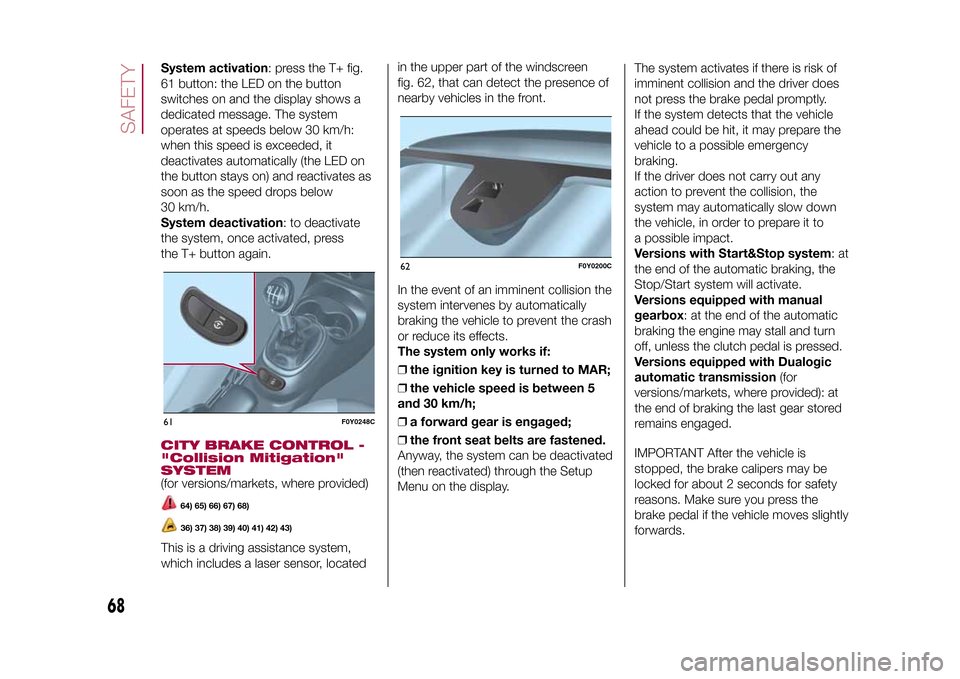
System activation: press the T+ fig.
61 button: the LED on the button
switches on and the display shows a
dedicated message. The system
operates at speeds below 30 km/h:
when this speed is exceeded, it
deactivates automatically (the LED on
the button stays on) and reactivates as
soon as the speed drops below
30 km/h.
System deactivation: to deactivate
the system, once activated, press
the T+ button again.CITY BRAKE CONTROL -
"Collision Mitigation"
SYSTEM(for versions/markets, where provided)
64) 65) 66) 67) 68)36) 37) 38) 39) 40) 41) 42) 43)
This is a driving assistance system,
which includes a laser sensor, locatedin the upper part of the windscreen
fig. 62, that can detect the presence of
nearby vehicles in the front.
In the event of an imminent collision the
system intervenes by automatically
braking the vehicle to prevent the crash
or reduce its effects.
The system only works if:
❒the ignition key is turned to MAR;
❒the vehicle speed is between 5
and 30 km/h;
❒a forward gear is engaged;
❒the front seat belts are fastened.
Anyway, the system can be deactivated
(then reactivated) through the Setup
Menu on the display.The system activates if there is risk of
imminent collision and the driver does
not press the brake pedal promptly.
If the system detects that the vehicle
ahead could be hit, it may prepare the
vehicle to a possible emergency
braking.
If the driver does not carry out any
action to prevent the collision, the
system may automatically slow down
the vehicle, in order to prepare it to
a possible impact.
Versions with Start&Stop system:at
the end of the automatic braking, the
Stop/Start system will activate.
Versions equipped with manual
gearbox: at the end of the automatic
braking the engine may stall and turn
off, unless the clutch pedal is pressed.
Versions equipped with Dualogic
automatic transmission(for
versions/markets, where provided): at
the end of braking the last gear stored
remains engaged.
IMPORTANT After the vehicle is
stopped, the brake calipers may be
locked for about 2 seconds for safety
reasons. Make sure you press the
brake pedal if the vehicle moves slightly
forwards.61
F0Y0248C
62
F0Y0200C
68
SAFETY
9-1-2015 12:9 Pagina 68
Page 71 of 224
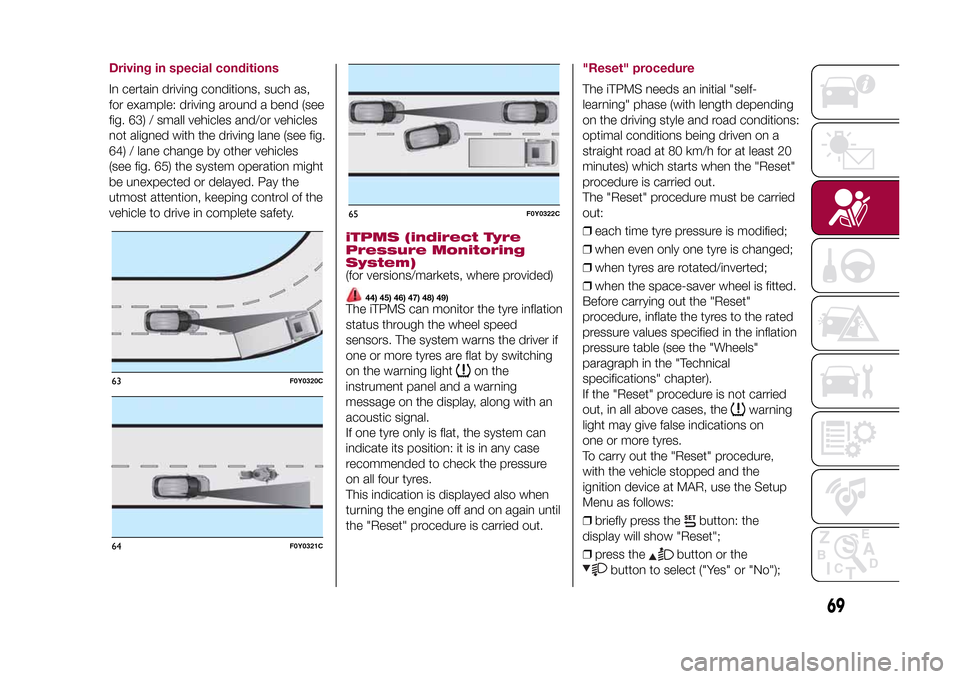
Driving in special conditionsIn certain driving conditions, such as,
for example: driving around a bend (see
fig. 63) / small vehicles and/or vehicles
not aligned with the driving lane (see fig.
64) / lane change by other vehicles
(see fig. 65) the system operation might
be unexpected or delayed. Pay the
utmost attention, keeping control of the
vehicle to drive in complete safety.
iTPMS (indirect Tyre
Pressure Monitoring
System)(for versions/markets, where provided)
44) 45) 46) 47) 48) 49)
The iTPMS can monitor the tyre inflation
status through the wheel speed
sensors. The system warns the driver if
one or more tyres are flat by switching
on the warning light
on the
instrument panel and a warning
message on the display, along with an
acoustic signal.
If one tyre only is flat, the system can
indicate its position: it is in any case
recommended to check the pressure
on all four tyres.
This indication is displayed also when
turning the engine off and on again until
the "Reset" procedure is carried out.
"Reset" procedureThe iTPMS needs an initial "self-
learning" phase (with length depending
on the driving style and road conditions:
optimal conditions being driven on a
straight road at 80 km/h for at least 20
minutes) which starts when the "Reset"
procedure is carried out.
The "Reset" procedure must be carried
out:
❒each time tyre pressure is modified;
❒when even only one tyre is changed;
❒when tyres are rotated/inverted;
❒when the space-saver wheel is fitted.
Before carrying out the "Reset"
procedure, inflate the tyres to the rated
pressure values specified in the inflation
pressure table (see the "Wheels"
paragraph in the "Technical
specifications" chapter).
If the "Reset" procedure is not carried
out, in all above cases, the
warning
light may give false indications on
one or more tyres.
To carry out the "Reset" procedure,
with the vehicle stopped and the
ignition device at MAR, use the Setup
Menu as follows:
❒briefly press the
button: the
display will show "Reset";
❒press the
button or the
button to select ("Yes" or "No");
63
F0Y0320C
64
F0Y0321C
65
F0Y0322C
69
9-1-2015 12:9 Pagina 69
Page 72 of 224
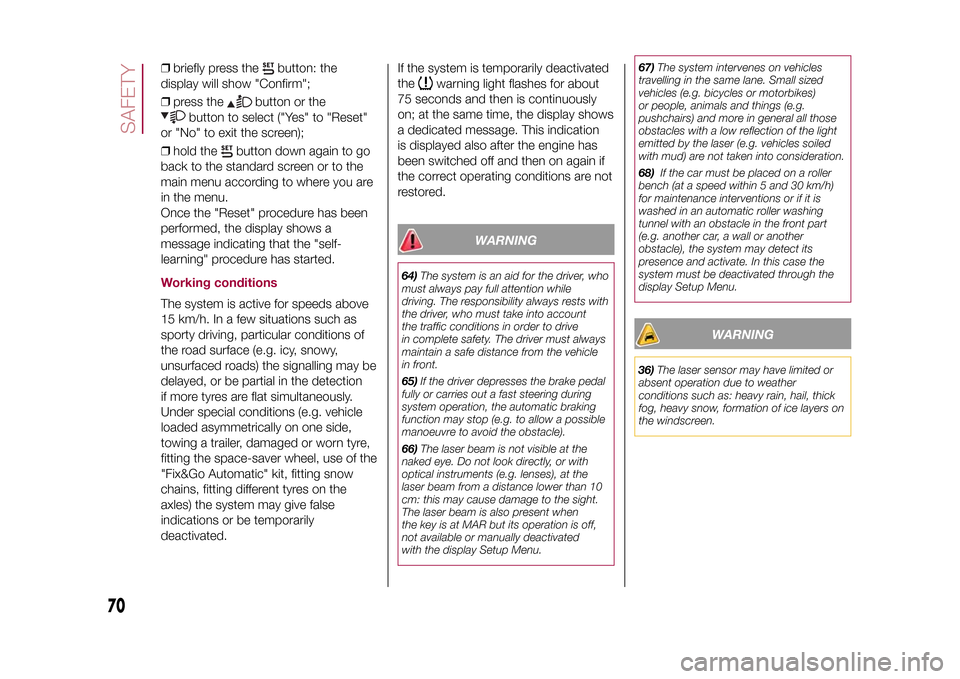
❒briefly press the
button: the
display will show "Confirm";
❒press the
button or the
button to select ("Yes" to "Reset"
or "No" to exit the screen);
❒hold the
button down again to go
back to the standard screen or to the
main menu according to where you are
in the menu.
Once the "Reset" procedure has been
performed, the display shows a
message indicating that the "self-
learning" procedure has started.
Working conditionsThe system is active for speeds above
15 km/h. In a few situations such as
sporty driving, particular conditions of
the road surface (e.g. icy, snowy,
unsurfaced roads) the signalling may be
delayed, or be partial in the detection
if more tyres are flat simultaneously.
Under special conditions (e.g. vehicle
loaded asymmetrically on one side,
towing a trailer, damaged or worn tyre,
fitting the space-saver wheel, use of the
"Fix&Go Automatic" kit, fitting snow
chains, fitting different tyres on the
axles) the system may give false
indications or be temporarily
deactivated.If the system is temporarily deactivated
the
warning light flashes for about
75 seconds and then is continuously
on; at the same time, the display shows
a dedicated message. This indication
is displayed also after the engine has
been switched off and then on again if
the correct operating conditions are not
restored.
WARNING
64)The system is an aid for the driver, who
must always pay full attention while
driving. The responsibility always rests with
the driver, who must take into account
the traffic conditions in order to drive
in complete safety. The driver must always
maintain a safe distance from the vehicle
in front.
65)If the driver depresses the brake pedal
fully or carries out a fast steering during
system operation, the automatic braking
function may stop (e.g. to allow a possible
manoeuvre to avoid the obstacle).
66)The laser beam is not visible at the
naked eye. Do not look directly, or with
optical instruments (e.g. lenses), at the
laser beam from a distance lower than 10
cm: this may cause damage to the sight.
The laser beam is also present when
the key is at MAR but its operation is off,
not available or manually deactivated
with the display Setup Menu.67)The system intervenes on vehicles
travelling in the same lane. Small sized
vehicles (e.g. bicycles or motorbikes)
or people, animals and things (e.g.
pushchairs) and more in general all those
obstacles with a low reflection of the light
emitted by the laser (e.g. vehicles soiled
with mud) are not taken into consideration.
68)If the car must be placed on a roller
bench (at a speed within 5 and 30 km/h)
for maintenance interventions or if it is
washed in an automatic roller washing
tunnel with an obstacle in the front part
(e.g. another car, a wall or another
obstacle), the system may detect its
presence and activate. In this case the
system must be deactivated through the
display Setup Menu.
WARNING
36)The laser sensor may have limited or
absent operation due to weather
conditions such as: heavy rain, hail, thick
fog, heavy snow, formation of ice layers on
the windscreen.
70
SAFETY
9-1-2015 12:9 Pagina 70
Page 75 of 224

WARNING
69)Never press button C fig. 66 when
travelling.
70)Remember that in the event of a violent
impact the rear seat passengers not
wearing seat belts are exposed to a very
serious risk and also represent a serious
danger for the front seat occupants.
SBR (Seat Belt
Reminder) SYSTEMThis system consists of a device which,
in conjunction with the
warning
light coming on in the instrument panel
fig. 70 (initially in fixed mode with
continuous acoustic signal and then in
flashing mode with intermittent acoustic
signal), warns the driver and front
passenger that their seat belts have not
been fastened.
To deactivate the acoustic warning
permanently go to a Fiat Dealership.
The acoustic warning can be
reactivated at any time through the
display Setup Menu.
DRIVERIf the driver is the only occupant and
the seat belt is not fastened, when 20
km/h is exceeded or when travelling
at a speed from 10 to 20 km/h for
longer than 5 seconds, an acoustic
signal sequence will be started (front
seats) consisting of a tone for 6
seconds followed by a 90 second
beep. The
warning light will flash.
The warning light will stay on constantly
at the end of the cycle until the engine
is stopped. The acoustic signal will
be interrupted immediately when the
driver's seat belt is fastened and the
warning light will switch off.
The reminder cycle (acoustic and visual)
will be repeated as described above if
the seat belt is unfastened while
travelling.
PASSENGERA similar solution applies for the
passenger, but the indication is
interrupted when the passenger leaves
the car as well.
If both the front seat belts are
unfastened with car in motion and
within a few seconds one from
the other, the acoustic signal and
activation of the warning light will refer
to the most recent event.
70
F0Y0116C
73
9-1-2015 12:9 Pagina 73
Page 96 of 224

WARNING
99)It is dangerous to run the engine in
enclosed areas. The engine burns oxygen
and releases carbon dioxide, carbon
monoxide and other toxic gases.
100)Remember that the brake servo and
power steering are not operational until the
engine has been started, therefore you
need to apply much more force than usual
to the brake pedal and steering wheel.
101)If the engine fails to start with a gear
engaged, the potentially dangerous
situation due to the fact that the gearbox is
automatically placed in neutral will be
signalled by an acoustic signal.
WARNING
51)Warning light
flashing for 60
seconds after starting or during prolonged
cranking of the engine indicates a fault
with the glow plug heating system. You
can use the vehicle as usual if the engine
starts but you should contact a Fiat
Dealership as soon as possible.
52)It is advisable not to demand maximum
performance from your vehicle (e.g.
excessive acceleration, long distances at
maximum rpm, excessively intense braking,
etc.) when it is first used.
53)When the engine is off, do not leave
the key turned to MAR to prevent
unnecessary electrical consumption from
draining the battery.54)Never jump start the engine by
pushing, towing or coasting downhill.
These actions could cause the fuel to flow
into the catalytic converter and damage
it beyond repair.
55)Revving up before stopping the engine
is useless, it causes unnecessary fuel
consumption and can damage the engine,
in particular engines equipped with
turbocharger.
HANDBRAKE
102) 103)
The handbrake lever is located between
the two front seats.
Handbrake engagement: pull lever A
fig. 89 upwards until the vehicle is
braked. Four or five clicks are generally
enough when the car is on level
ground, while ten or eleven may be
required if the car is on a steep slope
and laden. If this is not the case,
contact a Fiat Dealership for
adjustment.
Handbrake disengagement: slightly
raise lever A and hold button B pressed
checking that the
warning light
switches off in the instrument panel.
89
F0Y0047C
94
STARTING AND DRIVING
9-1-2015 12:9 Pagina 94